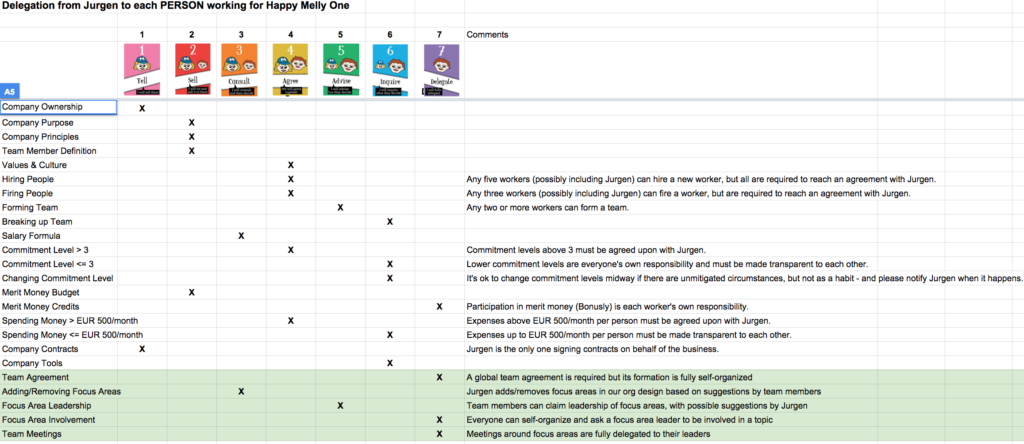At the start of 2016 we realised that we were making decisions that weren’t supposed to be made, without the approval of the rest of the team and asking questions that we didn’t need to ask, as they were clearly marked on the delegation board. It wasn’t just new team members that were doing this, even the CEO was guilty of firing someone without asking the team first.
When my colleague, Jennifer Riggins flagged this up, we realised it was time to review the delegation board. We hadn’t done so for over six months, and a lot had changed since then.
This is what the board looked like originally:
During our meeting we reviewed the first half of the board. The main delegation topic was about ‘Firing People’, as the week before Jurgen had the unfortunate task of firing a team member, which our team had not been party to until after the event. We discussed why this was necessary.
- She had been given various warnings
- She was not collaborating as part of the team
- She was not regularly reporting her work progress
- She was unable to use the tools that were essential to her role
- She had in the last few days of her employment, made a couple of errors that undoubtedly brought into question her suitably for the role
We understood that things weren’t working out as they should, but we are a team that always gives benefit of the doubt. Jurgen who was in contact with her on a daily basis, saw the situation become impossible.
Had we been asked, it was a decision we would all have agreed upon. We accepted that on this occasion, the decision was made with extreme urgency. It highlighted, however, the need to review the delegation board.
Was waiting for a unanimous decision from 15 team members a practical scenario?
Firing people on our delegation board ranked as a 4 – it had to be a team agreement. During our discussion we agreed that it wasn’t always possible to get 15 people together to make a decision about something as significant, and often immediate as firing a person. We agreed to keep the delegation at level 4, but to decrease the size of the people that needed to agree on the decision, and that decision always had to be accepted by Jurgen.
Another situation arose over the purchasing of a domain name for the Management 3.0 Online Training Academy. Our online course creator, Pilar Orti was confused when four people got involved over this small purchase, when our delegation board clearly stated that any purchase under 500 € didn’t need authorisation.
As we reviewed the board, we realised that most of the delegation cases were still relevant and correct for our current team, but we learnt that it’s important to review your delegation board at least every six months, or during organizational change or restructure. Levels of existing delegation areas can be realigned and the team can decide if there are areas of responsibility that need to be added or taken away.
The review also clarified the delegation areas for new team members, and the existing team were prompted on their delegation responsibilities.
This is what our Delegation Board looks like after the update:
As a remote team, our delegation board is stored in our shared Google Drive. If you have an onsite team, then your board should take pride of place somewhere in the office, so that it can be checked on a regular basis, and reviewed even more frequently if necessary.





Nice! I made a delegation board that had a comments and questions column. To answer common questions and also help the virtual team come to an agreement. Thank you for sharing transparently the Happy Melly team process, nice learnings!